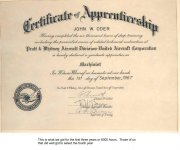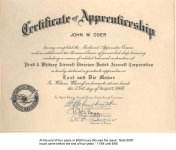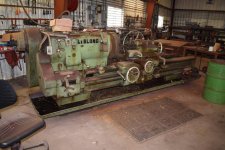John Oder:
Thanks for posting this thread. I have a bit of history with the heavier-duty/wide-bed LeBlond lathes, so this thread is something I appreciate. As I have posted on this 'board at various times, I was fortunate in having had the opportunity to specify and then purchase some used LeBlond lathes for the NY Power Authority during my employment there.
The lathe in this thread reminds me of a 25" x 96" LeBlond lathe I purchased for use in the machine shop at the hydro electric powerplant that I eventually retired from. This LeBlond lathe was furnished as a used/reconditioned/modified machine tool by Yancey Machine Tool Company of Portland, Oregon. I may be off base in my recollection, but I think it was designated by LeBlond as an NSK or something like it. The lathe we purchased from Yancey Machine Tool was a circa 1965 machine tool, and had been ordered with the 'servo shift' mechanism in the headstock. We had Yancey convert the headstock back to manual shifting. The bed was quite wide, and had the 'ratchet teeth' to take the thrust of the tailstock. The bed also had the replaceable hardened steel ways. Being a newer machine than 1940's, this lathe was delivered with a ball screw for the cross feed screw, and also has a 'pancake' style motor on the apron for rapid traverse in both 'long' and 'cross' feed directions.
By the 60's, LeBlond was building these lathes with cam-lock spindle noses. When we first saw the lathe, it had a DC (direct current) motor to drive the spindle, rated at 50 HP. We had Yancey down-size to a 25 HP AC motor with programmable VFD. That 25 HP motor was more than ample for anything we did in the powerhouse machine shop.
I may be off-base in saying this, but each of the 'old line' US lathe builders had a particular niche. Hendey was, in my opinion, on the lighter end of classic US engine lathes, and tended to be more of the toolroom lathes. Lodge & Shipley and American Tool Works built beefier lathes. Monarch and Sidney went in for some combination of toolroom lathe with plenty of iron, and Sidney was the pinnacle with the herringbone geared headstocks. Monarch ran a close second with helical gearing. Old timers I worked with used to tell me that Monarch and Sidney lathes had the smoothest running headstocks, and were preferred for fine work where any sort of 'imprint' of gear teeth in the headstock on the work would be a problem. Jobs like boring high speed plain bearings for things like turbo machinery were the kind of thing that Monarch and Sidney lathes were preferred for.
LeBlond was known for sheer brute strength. They had spur gearing in the headstocks, and plenty of iron. The late Robert Yancey schooled me on heavy engine lathes, and he believed LeBlond was "the" lathe for heavy work. The lathe in this thread appears to be a predecessor of the 25" x 96" LeBlond lathe I bought from Yancey Machine Tools for the powerhouse machine shop.
As an aside, the tailstock on the 25" x 96" LeBlond lathe I bought came fitted with a 'one shot' pressure lubricator (Bijur, I think), on the tailstock base. Before moving the tailstock, this Bijur lubricator was given a shot or two. The way lube was conducted thru drillings in the tailstock base to get some lift between the tailstock base and the bedways.
The tailstock on that 25" LeBlond lathe has 2-speed gearing to the quill. One speed gives a relatively fast quill travel with moderate force. In the lower range, we were cautioned that the force developed on the tailstock quill could shorten the life, or destroy, a live tailstock center.
LeBlond built very solid and basic designs of lathes. They had a good thing and stuck with it for the most part. I remember the first time I inspected the headstock gearing on a LeBlond wide bed lathe that swung work 60" over the cross-slide. We were buying that lathe also from Yancey Machine Tool. When I got a look inside the headstock, my first words were: "rock crusher gearing". That bigger LeBlond lathe had a faceplate which was permanently mounted on the spindle. The inner circumference of that faceplate had 'as-cast' internal ring gear teeth. A handwheel on the side of the headstock slid a pinion shaft (external to the headstock) into engagement with the internal ring gear teeth on that faceplate. If extremely slow spindle speeds and 'extra deep reduction' was wanted, the external pinion drive was used. Otherwise, a conventional drive thru the internal headstock gearing to the spindle was used for higher spindle speeds. We had gotten a set of what I call "boring mill jaws" (my term, maybe incorrect) for the faceplate. These jaws fit into the tee slots and were individually adjustable, converting the faceplate into a 4 jaw chuck.
I considered myself as having 'arrived' when I purchased that big LeBlond lathe, a lathe so big you needed a bridge crane to setup or remove jobs from it, and a lathe so big that a set of steps was needed to adjust the jaws on the faceplate. We converted that lathe from a 1950's DC drive to AC motor with VFD, and added DRO.
I was pleasantly surprised at how accurate those heavy duty/wide bed LeBlond lathes were. Robert Yancey had told me that, if a person wanted the heaviest duty and most solid US built engine lathe, they had to look to LeBlond. Mr. Yancey may have had some bias in that regard, having met R.K. LeBlond and discussed lathe designbs with him many years prior to my meeting Mr. Yancey. Seeing the 'rock crusher gearing' in the heavy duty/wide bed LeBlond headstocks as compared to the likes of Monarch or L & S or American Tool Works always left me wondering how such seemingly crude, coarse gearing could produce good surface finishes.
Some of the members of this 'board actually worked at LeBlond (the late Rammerc, and Mister Honey come to mind). LeBlond had to have had some very large planers to handle the bed castings for the wide bed/heavy duty lathes. They also had to have had some very large surface or specialized 'way grinders' for precision grinding the hardened bedway inserts for the big lathes.
The era these wide bed/heavy duty lathes were made was a time in the USA when iron and steel foundries were perhaps also at their peak. Prior to WWII, steam locomotive designs had reached the point of using what is known as a 'cast engine bed'. This is a one-piece steel casting which incorporates an entire steam locomotive frame along with the cylinder block and a number of other parts. IMO, the 'engine bed' castings were the pinnacle of foundry work in the USA.
During that same era, it was no problem for LeBlond to have wide bed/big swing lathe headstocks, beds, and other parts cast in iron, semi steel, or steel.
I do not recall ever reading about LeBlond having an in-house foundry. My guess is they stuck to what they knew best, and that was machine tool design and building. Foundry work on larger castings is a trickier matter. If a foundry was capable or pouring complex large castings like steam locomotive 'engine beds', they could be counted upon to pour good castings for heavy duty/large capacity engine lathes.
LeBlond got things right: they believed in massive, properly designed castings for rigidity and 'mass dampening'. Modern machine tool builders tend to go for much light castings for machine tools of equivalent ratings to what LeBlond built. Buzz-words such as "computer modelling" and 'tuned' design are often used to describe the design of these lighter machine tools. For heavy work, there simply was, nor is there now, any substitute for the heavy castings LeBlond used in their lathes.
Call me a dinosaur, or whatever else you may, but I am unshakeable in the belief that with the demise of the US lathe builders, nothing has come along to equal them.
Hopefully, this heavy duty LeBlond lathe will get a new lease on life in a shop that needs a real, honest, heavy duty manual engine lathe.













